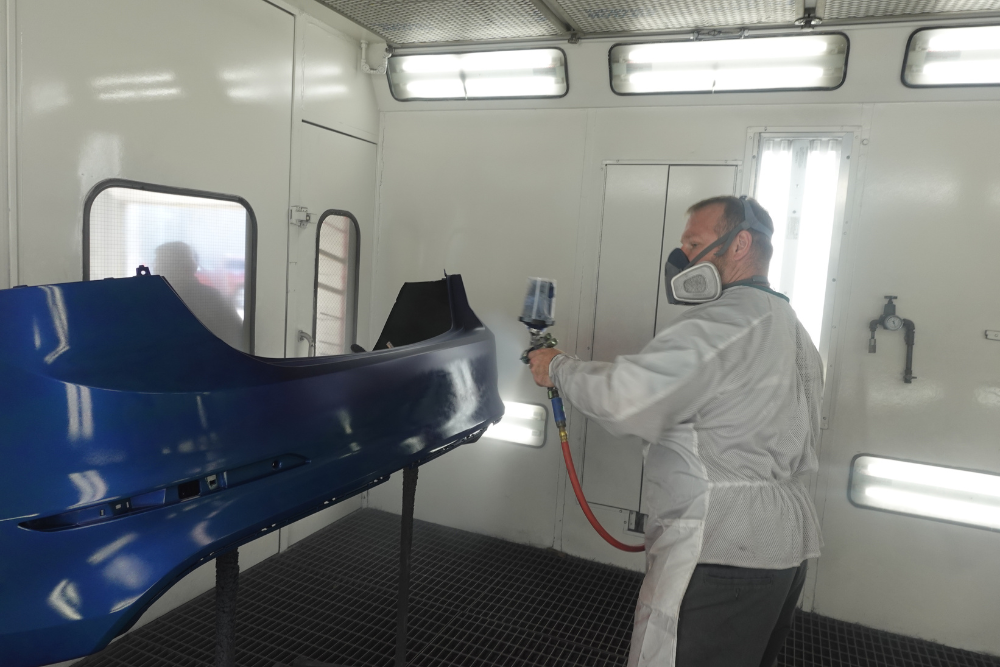Over the years, your vehicle’s paint may lose its luster and vibrancy, causing it to fade. Even though modern car paint is resilient, environmental factors will make it wear down, chip, and peel. Learn the reasons behind auto paint fading, find out how to restore it, and understand some methods to prevent damage in the future. Here is everything you need to know about fading paint on your vehicle.
What Makes Paint Fade?
Many vehicles stay outside throughout the day and night. Even if you have a garage, many factors can cause it to lose its color, gloss, and vibrancy. Fading is natural in many cars, but you can take a few steps to reduce its impact and appearance on your vehicle. Here are some of the common causes of auto paint fading.
UV Light
Sunlight is a factor that can cause paint to fade. When your car is frequently exposed to direct sunlight, the UV rays can gradually break down the color. In turn, that leads to oxidation and discoloration. Eventually, the sunlight can cause the car’s paint to lose its shine and vibrancy over time.
UV rays can penetrate the vehicle’s surface and break down the chemical bonds that hold the paint’s pigments together. When that happens, the pigments lose color, leading to a faded appearance. Additionally, UV rays can cause the clear coat on the paint to become brittle and crack, causing more damage.
Unfortunately, different paint colors have varying levels of resistance to UV rays. Generally, darker colors, such as black and dark blue, are more susceptible to fading than lighter colors. If you have a dark-colored car, you will want to take extra steps to protect it.
Rock Salt
During colder months, rock salt is often used to melt snow and ice on roads. While it can help prevent accidents, this salt can be highly corrosive and damaging to a vehicle’s paint. As cars drive over treated roads, the salt pellets can become lodged in the undercarriage, wheel wells, and other spots. When the salt is combined with moisture, it creates a corrosive mixture that can eat away at the paint, causing it to chip and peel.
As more road salt accumulates on the car’s surface, it will create a rough texture. In turn, that increases the likelihood of scratches and abrasions. This rough surface can also trap dirt and other particles, contributing to paint damage.
Animal Droppings
Bird droppings and urine are unsightly and can also be detrimental to your paint. These substances are highly acidic. They are known to cause severe damage to your vehicle’s paint if left untreated. The acidity can eat away at the protective layer of the car’s paint, causing discoloration, fading, and even corrosion. The longer these droppings stay on the surface, the more damage they can cause. You will want to clean them off as soon as possible.
Improper Washing and Care
Properly maintaining your car’s paint is vital to keeping it looking new and vibrant. However, improper care and washing techniques can cause debris to build up on the car’s surface. As a result, that can scratch the paint and fade it over time.
Always use the proper techniques and materials to avoid scratching the paint when washing your car. Using harsh and abrasive chemicals can strip the protective wax layer, leaving the paint exposed and vulnerable to damage. Additionally, using the wrong sponge or towel can cause scratches on the car’s surface.
Neglecting to wash your car regularly can also lead to damage. As dirt, dust, and other debris accumulate, they can scratch the paint when you drive.
How to Protect Your Paint
Maintaining the pristine appearance of your vehicle’s paint job enhances its aesthetic appeal and preserves its value. One of the easiest ways to prevent paint from fading is to park your car in covered areas. With that, you can reduce direct sunlight exposure, a common cause of paint fading. If you don’t have access to covered parking, consider investing in a car cover to provide additional protection.
Regularly washing your car with a gentle cleanser is another important step in maintaining the paint’s quality. Harsh chemicals and rough scrubbers can damage the paint, leading to fading and scratches. Using gentle car-safe towels will prevent swirl marks and maintain the paint’s shine.
Waxing your car is an effective method of revitalizing the paint’s appearance and vibrancy. Applying a wax coating every three to six months can protect the paint from damage caused by UV rays, dirt, and other environmental factors. The wax works like a shield and preserves the color and shine of the paint.
You also want to take precautions in cleaning the car’s exterior. Avoid using abrasive cleaners, like dish soap, since they can strip the protective wax layer and cause fading. Instead, use a specialized car shampoo and microfiber towels to clean the car gently.
Maintaining the paint job of your car requires regular care and attention. By following these tips, you can protect the paint from fading and extend the life of your car’s exterior.
Looking for an Auto Body Shop Near Me?
Elmer’s Auto Body has been a leading collision repair provider in South Jersey for over 75 years. As a family-owned and -operated business, we take pride in doing things differently from the other companies. With our exceptional knowledge, experience, and care, we ensure that your vehicle is repaired correctly. If you need a reputable auto body shop, call us at (856) 218-0202.

